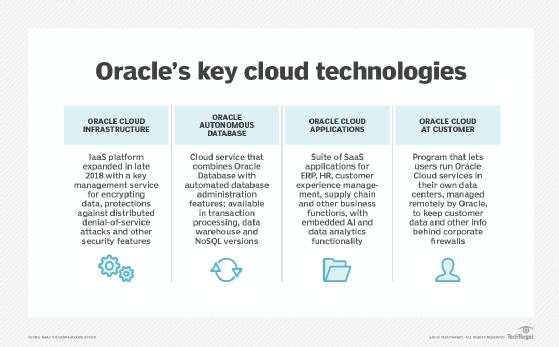
Getty Images/iStockphoto
Oracle Cloud Infrastructure targets devs and installed base
Though not the market leader, Oracle remains a feisty competitor in the competitive cloud computing market. Here are some added features and cost incentives introduced thus far.
Though Amazon Web Services, Microsoft Azure and Google Cloud own the lion's share of the cloud computing infrastructure service market, Oracle proves to be a scrappy competitor and a strong niche player with Oracle Cloud Infrastructure.
Oracle owns about 2% of the cloud infrastructure services market, according to the Synergy Research Group, a market research company in Reno, Nev. Oracle has a large on-premises and database-centric customer base which informs its decisions on migrations and hybrid offerings.
Oracle fortifies its features and polishes its incentives when it updates its services. The company is focused on pricing its offerings competitively, including discount services, a free tier of tools to deploy workloads on Oracle Cloud Infrastructure (OCI) and trying to pull in developers with cost-saving instance types to match workloads.
Here are four examples from this year.
Oracle offers on-premises support discount
To incentivize its existing customers into putting more apps into its own cloud, Oracle offers discounts on its software license maintenance and support fees. With Oracle Support Rewards, customers receive at least 25 cents off their maintenance costs for every dollar they spend on Universal Credits for OCI services. Customers with an Oracle Unlimited License Agreement save more and receive 33 cents for every dollar spent on OCI services.
These incentives help ensure existing customers stick with Oracle for cloud services instead of choosing AWS, Azure or Google. In this spirit, Oracle launched Oracle Cloud Lift in March, which offers free migration services for on-premises workloads.
But the Oracle Support Rewards program does not apply to Oracle's SaaS products, which run on its cloud infrastructure. The program is also restricted to Oracle's installed base. Third-party products or services resold by Oracle are not included in the offer.

Oracle Cloud targets developers with free services
Oracle added 13 services to the Always Free tier in June. These services target developers who wish to build a diverse mix of applications within the free tier. They include the following services:
- Arm-based Ampere A1 processors
- Autonomous JSON Database
- NoSQL Database Cloud
- APEX Application Development
- OCI Logging
- Service Connector Hub
- Application Performance Monitoring
- OCI Flexible Load Balancing
- Flexible Network Load Balancer
- VPN Connect V2
- Oracle Security Zones
- Oracle Security Advisor
- OCI Bastion
However, applications that use only Always Free services are restricted to one zone -- there are no resiliency and failover scenarios. Customers will pay more as their applications grow in complexity and require more advanced services.
Oracle wants to compete against market leaders, in particular against AWS, by offering a way to limit cost overruns that come due to unintentional spending. Other providers have a free tier, but OCI Always Free offers features that perform as "guardrails" to help developers track their spending and thereby not accidentally run up their bills.
Arm-based cloud instances target penny pinchers
In another bid to lure developers, Oracle entered the Arm-based processor market with OCI Ampere A1 -- its first Arm compute instances.
Rather than create its own Arm server CPU, Oracle will use Altra processors from Ampere Computing, a Santa Clara, Calif., startup that manufactures a cloud-native processor. These instances are priced at one cent per core hour and are expected to speed up application development and improve performance. Also, Oracle's development stack -- which includes Oracle Linux, MySQL, GraaIVM and the Oracle Container Engine for Kubernetes service -- is available on all Ampere A1 instances.
Oracle said it plans to create an Arm ecosystem composed of the Arm Accelerator program, the Oracle Cloud Free Tier and the App Development Ecosystem. This gives developers more options for compute instances and pricing compared to Intel processors on a per-core basis.
On top of these instances, Oracle has attempted to attract open source developers with its Oracle Linux Cloud Developer image -- which includes OCI client tools, Java, Python, PHP and Node.js.
OCI adds next-gen AMD EPYC instances
In March, Oracle added E4 instance types to help customers more closely match workloads and potentially cut costs.
At the same price as E3, Oracle has increased the power and capacity of the instances for E4 and offers bare-metal and VM-based deployments. Like E3, customers can choose how many OCPUs they want rather than deal with a fixed menu.
In terms of IaaS market share, Oracle may still lag behind the big three -- AWS, Microsoft and Google -- though its cloud infrastructure revenue continues to increase. It remains a viable option for many customers.








